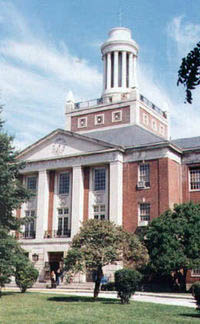
NEW YORK CITY (BP) — About 60 churches in New York City have less than two months to find a home before a court ruling takes effect and forces them to abandon the city’s public school buildings.
The congregations, including six that are Southern Baptist, have known for years that this date might be coming, but that fact hasn’t made it any easier for them to move by Feb. 12. The case dates back to 1994.
The churches were meeting in the buildings on Sundays, when school was not in session.
“Effectively, they’re homeless on the second Sunday in February,” George Russ, executive director of the Metropolitan New York Baptist Association, told Baptist Press. “They’re all scrambling to figure out where they can go and how they can make a good transition in their neighborhood.”
The legal case drew to a close in 2011 when the U.S. Second Circuit Court of Appeals upheld a New York City Department of Education rule that prevents school buildings from being used for “religious worship services.” Conservative groups had expected the Supreme Court to take the case and reverse the Second Circuit, but the high court declined in early December to even hear the case. The city council or the New York legislature could nullify the rule, but Russ said he isn’t optimistic that will happen.
The Southern Baptist congregations range in size from about 75 to approximately 400. That largest church, The Journey, might have the toughest time finding a space.
“You don’t find that in too many places,” Russ said.
Movie theaters are a possibility, Russ said, but their hours aren’t as flexible and they’re also more expensive. Movie theaters in New York City, he said, tend to open for business earlier than those in other cities.
The schools were charging the congregations only a nominal fee. There are other possibilities: hotels, Elks Lodges and receptions halls. All, though, will come at a higher price financially. And all need to be in the general vicinity of their current location.
“A church needs to be in a neighborhood where your people come from,” Russ said. “A church member is not going to commute from Queens to Manhattan just to go to church one day a week. Very few churches in the city are cosmopolitan in the sense that they draw from every borough.”
The congregations, Russ said, had “extremely positive” relationships with the schools.
“The churches that I work with have excellent relationships with the school administrators and had even gone and done extra projects to express their appreciation,” he said.
One SBC church in the city, Russ said, bought new furniture for a teacher’s lounge. Another church gave video equipment to a school’s video production staff. One church planter has even headed up a team of volunteers during the past few years to paint various schools. Last year, they worked at three different schools.
“Now we can’t even meet in the schools. So it’s quite ironic,” Russ said.
The Metropolitan New York Baptist Association’s office space has a chapel with about 100 seats that can be used for one church until it finds more permanent space, Russ said.
Perhaps surprisingly, church leaders are positive about the situation.
“It is an inconvenience, but they are saying, ‘Our identity is not in a building,'” Russ said. “‘Our identity is who we are as a body.’ It forces them to rethink their whole ministry strategy. Some are thinking about decentralizing, saying maybe we need two locations instead of one because of where our people come from. I think some are looking at this really from a real prayerful and missional kind of way, saying, ‘How can we best be the body of Christ in this city’? I’m trusting that God’s going to use this for His good.”
The case was Bronx Household of Faith v. Board of Education.
Jordan Lorence, an attorney with the Alliance Defense Fund organization that fought the city rule in court, said churches in other cities that meet in school buildings should not necessarily be concerned. New York City, he said, is the only city among the Top 50 U.S. school districts with such a law.
“The Supreme Court has not repudiated its earlier decisions supporting the First Amendment rights of religious groups to meet in public buildings on the same terms as other community groups,” Lorence wrote in an analysis piece. “What the Supreme Court did Dec. 5 is decline to review the Bronx Household of Faith decision. Although this was very disappointing, the court’s action did not affirm the lower court ruling, or repudiate any of its earlier opinions supporting equal access for religious groups. Equal access is still the law of the land, according to the Supreme Court.”
Most federal appeals courts, he wrote, “have rejected what the appeals court in New York approved.”
–30–
Michael Foust is associate editor of Baptist Press.
Get Baptist Press headlines and breaking news on Twitter (@BaptistPress), Facebook (Facebook.com/BaptistPress) and in your email (baptistpress.com/SubscribeBP.asp).

















